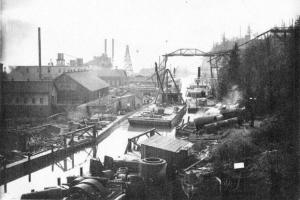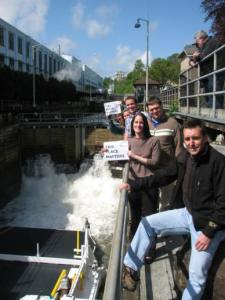One of the oldest and most storied historic structures in Oregon is not a building! From 1873 until their closure in 2011, the Willamette Falls Locks made navigation on the Willamette River possible. Because the locks sit opposite to the old Blue Heron paper mill site now being redeveloped in Oregon City, we see the potential for them to play a key role in a larger regional strategy for economic development. Take a moment to appreciate their place in Oregon history and their potential for future commercial and recreational use. — Peggy Moretti
Army Corps of Engineers gives talk on “Willamette Falls Locks — Past, Present & Future” at Museum of the Oregon Territory in Oregon City
Wednesday, October 22nd, 2014 at 6:30 PM
Louis Landre of the U.S. Army Corps of Engineers will speak on the Past, Present and Future of the Willamette Falls Canal and Navigational Locks on Wednesday, October 22nd at 6:30 p.m. at the Museum of the Oregon Territory in Oregon City.
What do Leonardo Da Vinci, the Canby Ferry, and Howard Hughes’ “Spruce Goose” all have in common? The answer is in the history of the Willamette Falls Locks.
Willamette Falls, a 42-foot, horseshoe shaped basalt ridge, is the second largest by-volume waterfall in the country. It has always presented a restriction to navigation and transport of goods on the Willamette River. In 1873, the locks opened, connecting the upper and lower reaches of the Willamette River.

(Photo credit: Willamette Falls Heritage Foundation)
What are the Locks?
The Willamette Falls Locks are the oldest, smallest multi-lift bypass canal used continuously for commercial purposes in the United States. The canal has four lift-chambers, cut through a solid rock shelf on the west side of the great falls that span the Willamette River between West Linn and Oregon City. Each chamber provides a 10-12 foot elevation change, and can accommodate vessels up to 175 feet long and 39 feet wide. The Willamette Falls Locks are listed as one of Oregon’s most endangered places by “Restore Oregon,” were named a “National Treasure” in 2012 by the National Trust for Historic Preservation, and have been on the National Register of Historic Places since 1974. The locks are also recognized as a State Historic Civil Engineering Landmark.
Pre-Locks Transportation Problems
Since time immemorial, Clackamas, Chinook, Central Kalapuya and other Oregon tribes carried (or “portaged”) small vessels around the natural obstacle of the Willamette Falls. In the fur trade era, “bateaus” carrying grain and produce to the Hudson’s Bay Company required passengers to walk along an overland trail by foot, while heavy cargo was transported by mule wagon. The lightened boats were hoisted up or down the falls via “cordelling,” and eventually reloaded.
Building the Locks
Initiated in 1868, the locks took five years to complete, funded in part by $200,000 in gold bonds raised by the State of Oregon. A project of the People’s Transportation Company, construction was financed and championed by pioneer promoters such as Bavarian-born Jewish-American Bernard Goldsmith, Portland’s Mayor from 1869-1871, and others. The locks were built before the onset of concrete technology. The canal walls were augmented with massive basalt blocks quarried from the Clackamas River area, with the great effort of Chinese manpower, and hand-fit by European stonemasons.
Leonardo DaVinci & The Gates

The seven gates in the Willamette Falls Locks are engineered with a leaf design taken directly from drawings by Italian inventor Leonardo DaVinci. The locks retained their functional integrity for well over a century, helping to transform Oregon from a pioneer state into a thriving industrial economy.
Rise & Fall of The Locks
At the peak of the steamboat era in Oregon, the Willamette Falls Locks allowed safe, efficient navigation for passengers and freight, connecting Portland, the Columbia River, and even far-off international markets to products from up-river farms and businesses. Although shipping rates fell dramatically as soon as the locks opened in 1873, both passenger travel and shipping on the Willamette began to decline within just a few decades of the locks completion, replaced almost entirely by railroad transportation by the early 20th century. The Corps of Engineers bought the locks in 1915 from Portland General Electric for $375,000.
Until WW2, the gates were opened and closed manually with a capstan mechanism. In the 1940’s, a hydraulic system replaced most of the manual labor, reducing the locks staff from over a dozen workers to only two. From the 1940’s to the mid 1970’s, an average of 1.5 million tons of commercial goods per year transited the locks— trending over time towards primarily logs and paper-products. Since then, small recreational and pleasure-craft use has increased, while commercial use has subsided. From time to time, however, the Locks prove surprisingly vital to contemporary transit.
The Spruce Goose
Howard Hughes’ infamous “Spruce Goose”, the Hercules H4 flying boat, was disassembled and transported through the locks in 1992 en route to McMinnville’s Evergreen Aviation Museum. In 1947, the H4 was the largest aircraft ever built. Hughes’ Hercules, as he preferred to call it, was constructed mostly of birch, not spruce, and flew only once, but still boasts an unsurpassed wingspan.

“This Place Matters” challenge in 2011.
(Photo credit: Sandy Carter)
Corps 2011 Closure
Due to corrosion and deterioration of the lock’s gudgeon arms (gate anchors), the Corps of Engineers determined that the locks’ infrastructure was potentially no longer safe to operate, and placed the locks into “non-operational status” in November of 2011.
River Travelers’ Comments
As to the Locks’ potential for heritage tourism and recreational use, although one Clackamas County Historical Society volunteer described the slow rising of water in the Locks’ lift chambers to be as entertaining as “watching grass grow,” visitors to CCHS museums are often keen to see them, and recognize the Locks as an historic engineering treasure. An out-of-state kayaking team in Oregon City last year insisted that the most difficult segment of their week-long trip exploring the Willamette— an American Heritage River and National Water Trail— was an awkward and unexpected portage around the Falls. Exhausted, they were fortunate to eventually be offered a ride by a West Linn resident with a pick-up truck. The many-hour ordeal, they said, would have been unnecessary, had the Locks been open to small craft.
The Canby Ferry
In January of 2013, the locks were opened to allow the Canby Ferry to pass through for needed repairs in Portland. Due to safety concerns, the Corps required the ferry to be pulled through the canal by hand, with no one aboard. “Moving the ferry by water saved Clackamas County a half million dollars from moving it overland” affirms Ms. Sandy Carter of the One Willamette River Coalition (OWRC). The historic ferry returned up river six months later in July of 2013, once again pulled manually through the lock’s chambers.
Future
The Corps has not received funding to operate the locks for either commercial or recreational use, due in part to funding priorities, which are based on annual tonnage. As low-use navigational locks, Willamette Falls Locks has low priority for available funds, as compared to high-use locks like those at Bonneville, The Dalles, and John Day. But to many, the lock’s historic, commercial and recreational value are worth fighting for. “Due to the enduring advocacy of the One Willamette River Coalition (OWRC) and the National Trust for historic Preservation, efforts continue in the quest for a healthy, busy future for the Willamette Falls’ historic four-chambered bypass locks,” states author and historic preservationist Sandy Carter. “The One Willamette River Coalition is fundraising to commission an economic benefits study on the locks through ECONorthwest,” Ms. Carter continued in a 2013 interview. “The OWRC and Peggy Sigler of the Trust are leading the movement to have the locks repaired, reopened, and eventually transferred out of Corps of Engineers ownership.”
The Museum of the Oregon Territory is operated by the Clackamas County Historical Society. Admission is free. Located off Hwy 99E, overlooking Willamette Falls, at 211 Tumwater Drive in Oregon City. Visit www.clackamashistory.org for more information, or call 503.655.5574.
Further reading: A closer look at potential benefits of locks reopening

